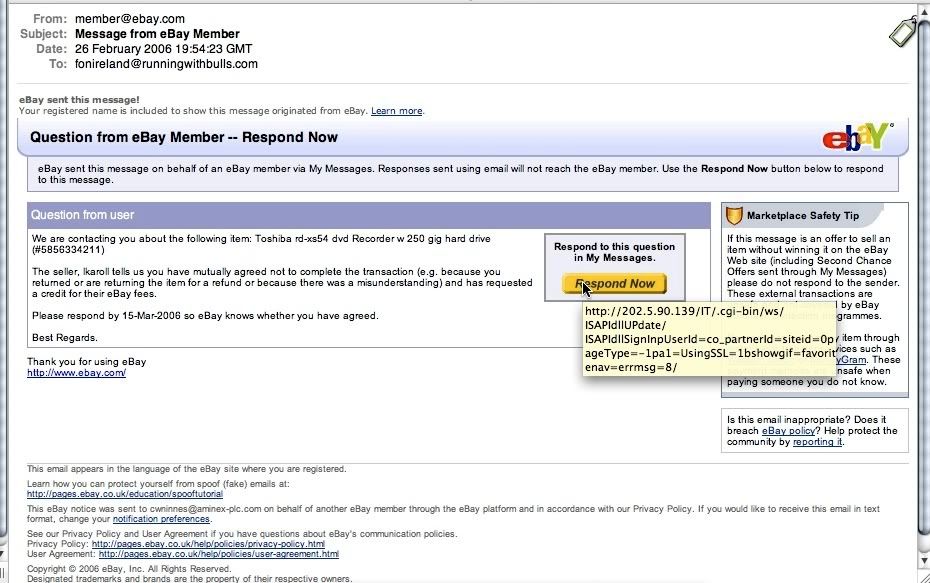Phishing is intentional acquiring of personal and sensitive information from the victim such as usernames, passwords and credit card details by masquerading as a business or individual. PayPal, eBay, credit card and online banks are common targets. Phishing is typically carried out by e-mail or instant messaging, and often directs users to enter details at a website, although phone contact has also been used.
There are few examples most popular of phishing cases to look through, eBay phishing. Scammers phish on eBay to obtain eBay ID's which then are used to sell fake or non-existent goods or such accounts can be sold further in the underground market. Many types of eBay scams exist. a victim of phishing?
MESSAGE FROM EBAY MEMBER
 This genuine looking email is a masquerade. As soon as you clicked on "respond", you were directed to an exact clone of eBay and your personal information was stolen. These messages come in different styles and writings. Go manually to ebay.com and check your private messages there and you will see if its real or not.
This genuine looking email is a masquerade. As soon as you clicked on "respond", you were directed to an exact clone of eBay and your personal information was stolen. These messages come in different styles and writings. Go manually to ebay.com and check your private messages there and you will see if its real or not.UPDATE CREDIT CARD INFORMATION
 Look at the link here. It looks as valid as it could. It is written http://signin.ebay.com, but this written link actually points again, yes, to a clone of ebay. This is done with a href code in html coding. I will show you an example. Click on this link:http://www.amazon.com/The Address shows ebay, but you were linked to amazon. I have linked you to amazon, but Con artist will link you to dupes of legit business websites and scam you. Beware what you click, your browser shows you the link in the left bottom corner if you only point over the link, without clicking it.
Look at the link here. It looks as valid as it could. It is written http://signin.ebay.com, but this written link actually points again, yes, to a clone of ebay. This is done with a href code in html coding. I will show you an example. Click on this link:http://www.amazon.com/The Address shows ebay, but you were linked to amazon. I have linked you to amazon, but Con artist will link you to dupes of legit business websites and scam you. Beware what you click, your browser shows you the link in the left bottom corner if you only point over the link, without clicking it.RE-ENTER ACCOUNT INFORMATION
 This whole email was actually an image which referred you to a scam website if you clicked anywhere on it. Your mouse cursor changed to a "hand", if you have this set as default when you point over a link.
This whole email was actually an image which referred you to a scam website if you clicked anywhere on it. Your mouse cursor changed to a "hand", if you have this set as default when you point over a link.Prevention Method
Install an Anti-phishing software-attempt to prevent fraudulent websites from masquerading as other legitimate web sites eg iTrustPage: An anti-phishing tool that prevents users from filling out suspicious Web forms, and suggests the corresponding legitimate form. It is an open source code, developed by people for people for free.
Ingore the thing links in suspicious e-mail.Company e.g. eBay all alike will never send you emails to enter your personal information! If you do receive a important notice from eBay or bank and you are in doubt if its real, close the email, start a new session with your internet browser.
If you got a private message to your email from a suspicious member, do the same as mentioned above.

No comments:
Post a Comment